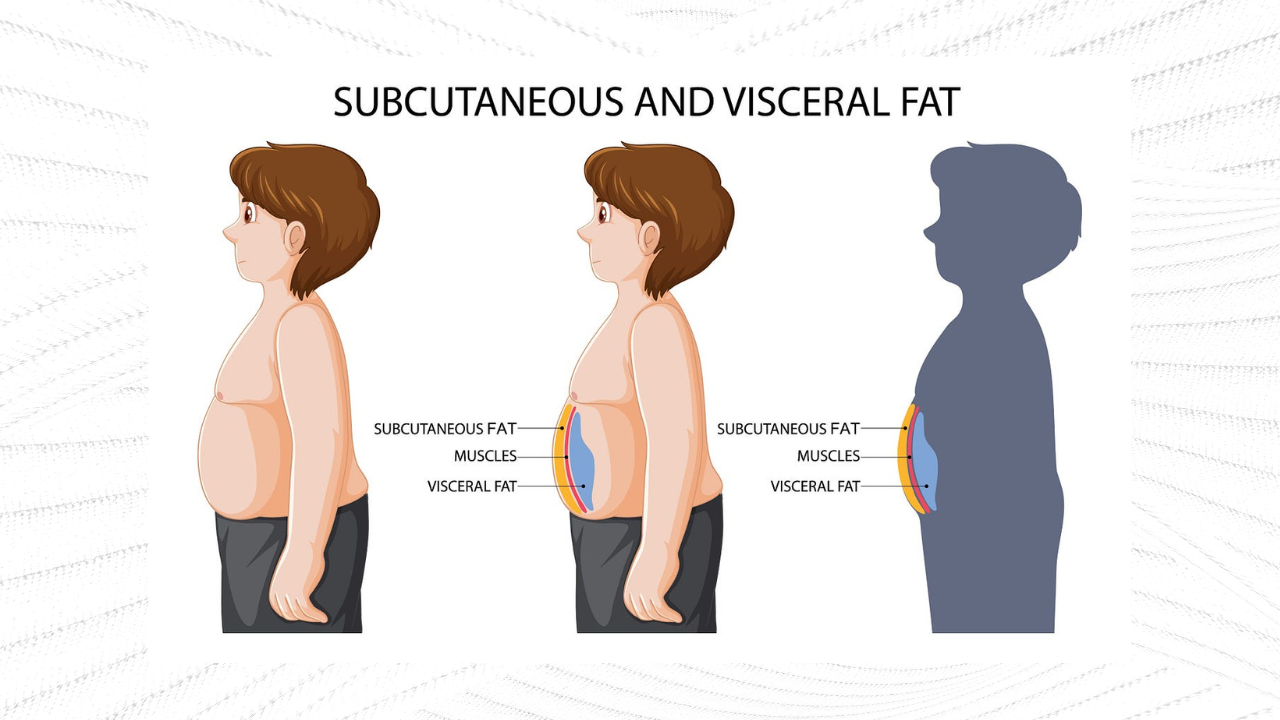Visceral fat, the sneaky fat that wraps around your vital organs, isn’t just a cosmetic concern—it’s a health hazard. Unlike the subcutaneous fat you can pinch, visceral fat lurks deep inside, around your liver, heart, and kidneys, silently increasing your risk for serious conditions like heart disease, diabetes, and even Alzheimer’s. The good news? You can reduce it with practical lifestyle changes. Let’s dive into what visceral fat is, why it’s dangerous, and how you can tackle it to live a longer, healthier life.
What Is Visceral Fat?
The Hidden Danger
Visceral fat is the fat stored deep within your abdominal cavity, surrounding organs like the liver, pancreas, and heart. Unlike the jiggly fat under your skin, this type is metabolically active, pumping out inflammatory chemicals that wreak havoc on your body. It’s linked to insulin resistance, high cholesterol, and even brain health issues, making it a key player in chronic diseases.
Why It’s a Problem
Even if you’re slim, you could have too much visceral fat—a condition sometimes called “skinny fat.” Studies show it can shrink the brain’s memory center and increase markers of Alzheimer’s, like beta-amyloid plaques, as early as your 40s or 50s. It’s a silent threat, but one you can measure and manage.
How to Know If You Have Visceral Fat
Simple Waistline Check
A quick way to gauge visceral fat is to measure your waist. For women, a waistline over 35 inches (88.9 cm) signals higher risk; for men, it’s over 40 inches (101.6 cm). Grab a tape measure, wrap it around your waist at belly-button level, exhale naturally, and check the number. No sucking in your gut—honesty is key here!
Other Indicators
Low muscle mass can also hint at visceral fat buildup, even if you don’t look “fat.” A DEXA scan, available at many clinics, measures visceral fat, muscle mass, and bone density. Biometric scales can provide similar insights at home. Poor diet and lack of exercise are also red flags, as they pave the way for fat accumulation over time.
Why Reducing Visceral Fat Matters
Protecting Your Heart and Brain
Visceral fat doesn’t just sit there—it actively harms your health. It’s linked to heart disease, type 2 diabetes, and fatty liver. Research also shows it can accelerate cognitive decline, increasing your risk for dementia. By reducing visceral fat, you’re not just slimming your waistline; you’re extending your health span.
Boosting Longevity
Keeping visceral fat in check can help you live longer and feel better. Doctors emphasize that lifestyle changes can reverse this fat buildup, giving you control over your health destiny.
Practical Ways to Reduce Visceral Fat
Move Your Body with Cardio and Strength
Exercise is your best weapon against visceral fat. Start with 30 minutes of brisk cardio daily—think walking, jogging, or cycling at a pace where talking is tough. Add resistance training to build lean muscle, which burns fat even at rest. Try compound exercises like deadlifts, lunges, or push-ups, which work multiple muscle groups at once.
Pro Tip: Combine cardio and strength by carrying weights while walking or biking uphill. Check with your doctor before starting, especially if you’re new to exercise.
Rethink Your Diet
Ditch the ultraprocessed foods—think chips, sodas, and fast food—and embrace whole, plant-based foods. The Mediterranean diet, rich in fruits, vegetables, nuts, seeds, and fatty fish like salmon, is a proven winner. Studies show it can reduce body fat and lower mortality risk by up to 25% in women over 25 years.
Quick Tip: Try time-restricted eating, like eating between 11 a.m. and 5 p.m., to shake up your body’s routine. It doesn’t work for everyone, but paired with a healthy diet, it can jumpstart fat loss.
Prioritize Sleep and Stress Management
Poor sleep and chronic stress can increase visceral fat by spiking cortisol, a hormone that promotes fat storage. Aim for 7-8 hours of quality sleep and practice stress-busting habits like mindfulness or yoga. Even a 10-minute daily meditation can make a difference.
Small Changes, Big Results
You don’t need to overhaul your life overnight. Start small: swap one sugary snack for a piece of fruit, take a 10-minute walk after dinner, or try a beginner’s strength workout. Consistency is key. Over time, these habits can shrink visceral fat, lower inflammation, and protect your heart, brain, and overall health.
Monitor Your Progress
Retest your waistline every few months, or use a biometric scale to track changes in fat and muscle mass. If you’re not seeing results, consult your doctor to rule out issues like low testosterone or other metabolic hurdles.
The Bottom Line
Visceral fat may be a hidden threat, but it’s not invincible. With regular exercise, a nutrient-rich diet, and healthy habits, you can reduce this dangerous fat and boost your longevity. Start today—your heart, brain, and future self will thank you.
Ready to take control? Sign up for our weekly wellness newsletter for more tips on living well, made simple.
